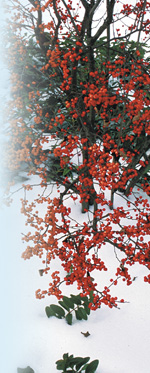Deck the Landscape With Hollies
go.ncsu.edu/readext?236295
en Español / em Português
El inglés es el idioma de control de esta página. En la medida en que haya algún conflicto entre la traducción al inglés y la traducción, el inglés prevalece.
Al hacer clic en el enlace de traducción se activa un servicio de traducción gratuito para convertir la página al español. Al igual que con cualquier traducción por Internet, la conversión no es sensible al contexto y puede que no traduzca el texto en su significado original. NC State Extension no garantiza la exactitud del texto traducido. Por favor, tenga en cuenta que algunas aplicaciones y/o servicios pueden no funcionar como se espera cuando se traducen.
Português
Inglês é o idioma de controle desta página. Na medida que haja algum conflito entre o texto original em Inglês e a tradução, o Inglês prevalece.
Ao clicar no link de tradução, um serviço gratuito de tradução será ativado para converter a página para o Português. Como em qualquer tradução pela internet, a conversão não é sensivel ao contexto e pode não ocorrer a tradução para o significado orginal. O serviço de Extensão da Carolina do Norte (NC State Extension) não garante a exatidão do texto traduzido. Por favor, observe que algumas funções ou serviços podem não funcionar como esperado após a tradução.
English
English is the controlling language of this page. To the extent there is any conflict between the English text and the translation, English controls.
Clicking on the translation link activates a free translation service to convert the page to Spanish. As with any Internet translation, the conversion is not context-sensitive and may not translate the text to its original meaning. NC State Extension does not guarantee the accuracy of the translated text. Please note that some applications and/or services may not function as expected when translated.
Collapse ▲
Winterberry
Photo by Robert E. Lyons
Mention hollies in December and most people think of the spiny evergreen that is used to deck the halls for the holidays. When it comes to the landscape, the diversity within the holly(Ilex) genus is neverending. These sturdy beauties can be evergreen or deciduous, small and spineless, or large and spiny. They are available in numerous shapes such as columnar, pyramidal and rounded. Homeowners use these plants for screens, hedges, mass plantings and specimen plantings.
Hollies are dioecious, meaning males produce pollen and females produce berries. Good fruit production can normally be expected if the male and female grow within 30 feet of one another. The resulting berries can be red, orange, yellow or black, depending on species. Hollies fall within the easy-to-care-for category. They prefer well-drained soil with full sun and slightly acidic soil, with the pH between 5.0 and 6.0. To maintain healthy plants, fertilize and mulch. Common insect pests of hollies include leaf miner, scale and red mites. Some of the Japanese cultivars can be very susceptible to root rot diseases.
One of my favorite evergreen hollies is Ilex crenata ‘Helleri.’ This Japanese holly survives well in many environments and makes a nice foundation plant, although it is susceptible to root rot. Another attractive choice is Ilex cornuta ‘Carissa.’ This Chinese holly has one single spine which makes for an interesting form. It is not as hardy as other varieties and seldom fruits. I also like the blue boy and blue girl combination, Ilex x meserveae, known as blue holly.

Blue Holly
Photo by Robert E. Lyons
A good deciduous holly is the Ilex decidua, possumhaw holly, which has beautiful winter color and grows to a small tree. Many cultivars are available. Another great deciduous holly is the common winterberry,Ilex verticillata.
The true hollies are a strong suit for the JC Raulston Arboretum. It would take some serious time to study the entire collection but you would certainly walk away with great ideas for your home landscape. Many specimens are mature and robust, exhibiting all the beauty the genus is renown for showing off!
Diane Ashburn


